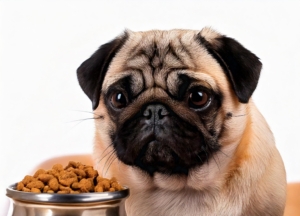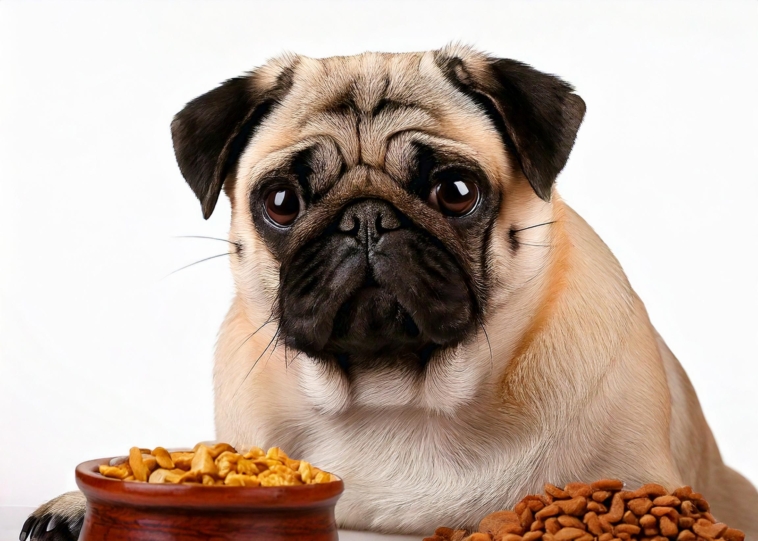Feeding Your Pug: Because Royalty Deserves the Best
Let’s be real—your pug is not a pet; they’re a four-legged potato with respiratory issues and a royal stomach. But your pug is not like kings and queens of yore who would lounge about eating turkey legs and buttered bread all day long. They have certain dietary needs due to their flat faces, sensitive skin, and joints that ring out like a haunted rocking chair at times.
If you’d like your squishy snuggle bug to flourish, not merely survive, you must take care of their plate. That is, provide them with foods that help them breathe better, itch less, and strut about like they own the place (because they do).
So What Does a Fancy Pug Eat?
Your pug is loaf-shaped, but their diet is anything but plain. This is what they actually require to remain fit, fabulous, and slightly self-assured:
- Protein: For building muscle so that they can pursue squirrels (or the mailman) like pros. Keep it high-grade—chicken, beef, fish.
- Fats: For a shiny runway-perfect coat and those marathon bursts of energy between snoozes.
- Carbs: Not for beach bodies, but to keep them racing back and forth between naps.
- Fiber: To get things moving (you know what we’re talking about). Veggies and grains will get the job done.
- Vitamins & Minerals: Because fabulousness takes a whole support crew.
- Water: Keep the bowl full. Drying out equals cranky pug.
And yes consult with the vet before making your kitchen a doggie bistro.
How to Shop Like Your Pug’s Personal Chef
Selecting food for a pug is not all about reaching for whatever’s marked down. Here are some things to consider when buying their gourmet meals:
- Ingredient Quality: If the top ingredient is “meat-ish,” flee. Opt for actual proteins such as chicken or lamb.
- No Funky Additives: If it reads like a chemistry problem, chances are it shouldn’t be in a dog bowl.
- Balanced Nutrition: Stick with AAFCO recommendations—because your pug did not learn nutrition in school.
- Allergy Awareness: Pugs can be drama queens about soy, corn, and wheat.
- Life Stage Matters: Puppies aren’t adults, and elder are… let’s just say “seasoned pros.” Feed accordingly.
- Brand Reputation: If the food’s been recalled more times than you’ve had hot dinners, maybe skip it.

The Best Pug Food Brands—AKA Pug-Approved Delicacies
Brand 1:
Perfect for transforming pugs with a rough exterior into shampoo ad models. Contains:
- Luxurious fats for glossy coats
- Sweet potatoes for energy (and attitude)
- Spinach and blueberries to improve their immune system—and wardrobe
- Prebiotics for royal digestion
Brand 2:
Formulated for the sensitive, muscular little fighters.
- Chicken and fish that won’t upset their royal tummies
- Omega fats for velvety smooth skin
- Probiotics so they can pass gas less theatrically
Brand 3:
For pugs who prefer to remain lean, limber, and cute.
- High-quality protein for those stumpy legs
- Carb management (because belly rolls need to be cute, not deadly)
- Joint care for jumping onto the couch without help
- Heart-healthy omega-3s so they love you longer
Brand 4:
…Well, you didn’t provide much information here, but let’s assume it’s full of goodness, specifically designed for little divas and young puppies alike.
Brand 5:
A balanced meal plan suitable for a diminutive, flat-faced emperor.
- Chicken and fish for toned muscle and infinite tail wags
- Antioxidants for overall “glow”
- Digestive support so what enters… well… exits peacefully
Whipping Up Homemade Cuisine for Your Little Gremlin
Want to go full “pugcuisine chef”? Here’s a shortlist of fine-dining items straight from the fridge:
Proteins:
- Chicken breast (cooked, not fried like your cheat day snack)
- Turkey (lean and mean)
- Fish (boneless, because we don’t want drama)
- Eggs (for a protein-packed breakfast bark)
Veggies (Steamed and Stylish):
- Carrots
- Green beans
- Sweet potatoes
- Peas (tiny, mighty, and fun to roll around the floor)
Grains:
Quinoa, oatmeal, brown rice—gourmet carbs for the sophisticated lad or lass
Fruits:
- Blueberries (antioxidant powerballs)
- Banana (sliced, since we’re not savages)
- Apple (no seeds, we’re not attempting to recreate “Snow White”)
Supplements:
- Fish oil (for shine)
- Calcium (for steel bones)
- Low-fat yogurt (dessert atmosphere)
Don’t feed your pug any poisonous garbage like chocolate, onions, or garlic if you don’t want an outrageously costly emergency vet trip.
Training Your Pug to Accept New Food (AKA: The Royal Transition)
Switching your pug’s chow isn’t a revolution—it’s a creeping coup. Do it this way:
- Gradual Mix: Begin by gradually adding a little of the new chow to the old. Gradually change the ratio over 7-10 days.
- Stick to the Clock: Feed at the same hour every day—pugs prefer routine, and so does their stomach.
- Monitor: If they begin scratching like a DJ or swelling up, halt and call the vet.
- Hydrate: Don’t forget the H2O. Royalty still has to drink.
The Grand Finale: Choosing the Best for Your Pug
Here’s the TL;DR:
- Ingredients Matter: Read the label. If it sounds like a science experiment, back away slowly.
- Age Counts: Treat a puppy like a puppy and an older one like a retiree on a beach.
- Call the Vet: They’re not just for shots—they’re your pug’s nutritional consultant.
Your pug may be small, squishy, and dramatically inclined—but with the proper diet, they’ll be healthier, happier, and likely snoring even more loudly than normal.




